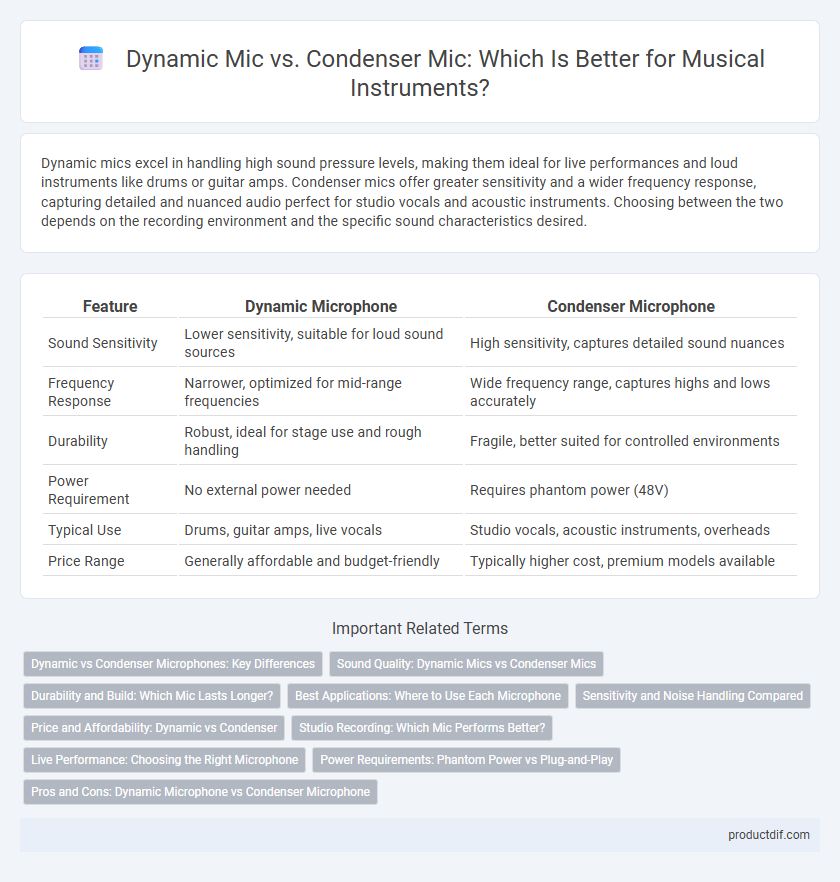Dynamic mics excel in handling high sound pressure levels, making them ideal for live performances and loud instruments like drums or guitar amps. Condenser mics offer greater sensitivity and a wider frequency response, capturing detailed and nuanced audio perfect for studio vocals and acoustic instruments. Choosing between the two depends on the recording environment and the specific sound characteristics desired.
Table of Comparison
| Feature | Dynamic Microphone | Condenser Microphone |
|---|---|---|
| Sound Sensitivity | Lower sensitivity, suitable for loud sound sources | High sensitivity, captures detailed sound nuances |
| Frequency Response | Narrower, optimized for mid-range frequencies | Wide frequency range, captures highs and lows accurately |
| Durability | Robust, ideal for stage use and rough handling | Fragile, better suited for controlled environments |
| Power Requirement | No external power needed | Requires phantom power (48V) |
| Typical Use | Drums, guitar amps, live vocals | Studio vocals, acoustic instruments, overheads |
| Price Range | Generally affordable and budget-friendly | Typically higher cost, premium models available |
Dynamic vs Condenser Microphones: Key Differences
Dynamic microphones utilize a moving coil to convert sound into electrical signals, making them durable and ideal for high sound pressure levels such as live performances. Condenser microphones use a capacitor to capture audio with greater sensitivity and a wider frequency response, excelling in studio settings for detailed sound recording. The choice between dynamic and condenser microphones depends on the use case, with dynamic mics preferred for rugged environments and condenser mics favored for capturing nuanced audio.
Sound Quality: Dynamic Mics vs Condenser Mics
Dynamic microphones offer robust sound quality with a warmer tone and excellent handling of high sound pressure levels, making them ideal for live performances and loud instruments. Condenser microphones provide superior sensitivity and a wider frequency response, capturing more detail and clarity, which is preferred in studio recordings for vocals and acoustic instruments. The choice between dynamic and condenser mics significantly impacts recorded sound quality, depending on the recording environment and instrument type.
Durability and Build: Which Mic Lasts Longer?
Dynamic microphones feature rugged construction with fewer sensitive components, making them highly durable and ideal for heavy use in live environments. Condenser microphones, while offering superior sensitivity and sound accuracy, typically have delicate diaphragms and require external power, which can make them more susceptible to damage over time. For longevity and reliability under rough conditions, dynamic mics generally outlast condenser mics due to their robust build and simpler internal mechanisms.
Best Applications: Where to Use Each Microphone
Dynamic microphones excel in live performances and loud sound sources due to their durability and high SPL handling, making them ideal for stage vocals, guitar amps, and drums. Condenser microphones capture detailed and accurate sound, perfect for studio recordings of vocals, acoustic instruments, and subtle nuances, benefiting from their higher sensitivity and wider frequency response. Choosing the right microphone depends on the environment and sound characteristics, with dynamic mics suited for rugged, high-volume settings and condensers favored in controlled, detailed recording spaces.
Sensitivity and Noise Handling Compared
Dynamic microphones exhibit lower sensitivity, making them ideal for high-volume environments and effectively handling loud sound sources without distortion. Condenser microphones offer higher sensitivity, capturing detailed nuances and subtle sounds, but they tend to be more susceptible to background noise and require quieter environments. Noise handling in dynamic mics excels due to their robust diaphragm and coil design, whereas condenser mics rely on external power and delicate components, resulting in increased noise pickup in untreated settings.
Price and Affordability: Dynamic vs Condenser
Dynamic microphones generally offer a more affordable option, making them ideal for beginners and budget-conscious users due to their simpler design and durable construction. Condenser microphones tend to be pricier because of their complex internal components and superior sensitivity, often preferred in professional studio settings. Choosing between dynamic and condenser mics depends largely on budget constraints and specific audio recording needs.
Studio Recording: Which Mic Performs Better?
Condenser microphones outperform dynamic mics in studio recording due to their superior sensitivity and wider frequency response, capturing detailed vocals and instruments with exceptional clarity. Dynamic microphones, while durable and capable of handling high sound pressure levels, often lack the nuanced sound reproduction required for precise studio work. For capturing subtle sonic textures and balanced audio, condenser mics are the preferred choice in professional studio environments.
Live Performance: Choosing the Right Microphone
Dynamic microphones excel in live performance settings due to their durability and ability to handle high sound pressure levels without distortion, making them ideal for vocals and loud instruments like drums and guitar amplifiers. Condenser microphones offer superior sensitivity and a wider frequency response, capturing vocals and acoustic instruments with greater detail but requiring controlled environments to avoid feedback and damage. Selecting the right microphone depends on the performance context, with dynamic mics favored for robust stage use and condensers preferred for clarity in less noisy settings.
Power Requirements: Phantom Power vs Plug-and-Play
Condenser microphones require phantom power, typically 48V, supplied through an audio interface or mixer to operate their internal electronics and capture detailed sound. Dynamic microphones are plug-and-play devices that do not need external power, making them ideal for live performances and situations without power sources. Phantom power can damage some dynamic mics, so proper equipment compatibility is essential when setting up audio systems.
Pros and Cons: Dynamic Microphone vs Condenser Microphone
Dynamic microphones offer durability and high sound pressure level handling, making them ideal for live performances and loud sound sources, while their limited frequency response can affect sound detail. Condenser microphones provide superior sensitivity and wider frequency range, capturing nuanced audio with clarity, but require external power and are more fragile, limiting their suitability for rugged conditions. Choosing between dynamic and condenser mics depends on the recording environment, sound source, and desired audio fidelity.
Dynamic mic vs Condenser mic Infographic

 productdif.com
productdif.com